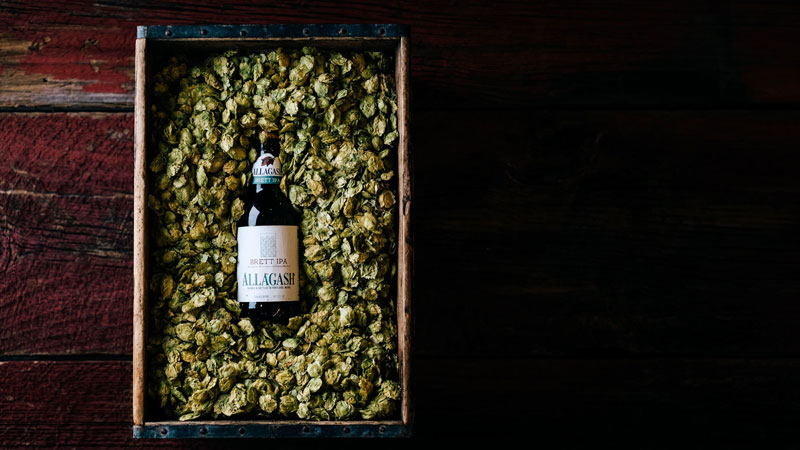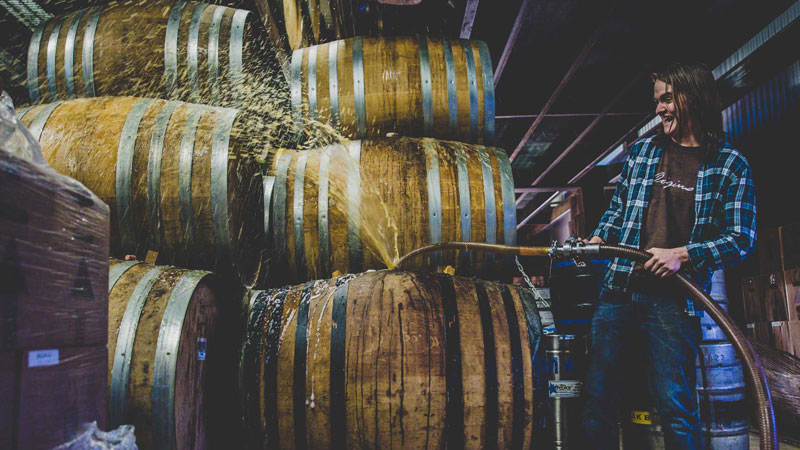Anyone who follows craft beer knows the drill. “NEW BEER ALERT!” your favorite brewery crows, announcing its latest offering via press release, Instagram post, or Facebook update. More and more, the announcements herald one of two types of beers: hazy IPAs, or a stout aged in some kind of barrel with whatever the brewery found in the pantry that day.
Of course, no brewery is going to stand out, garner acclaim, or achieve longevity by simply chasing trends. There’s a mindfulness to carefully curating what comes next.
Smart breweries know that inspiration for their next groundbreaking beers can come from anywhere: a meal on a recent business trip, the creative mind of the head brewer, or even Jeff in marketing. As craft beer becomes more popular and competitive, breweries hoping to innovate have to look beyond the usual suspects.
How they do it varies — as do the results. And that makes all the difference in the world.
The Next Big Brewer Might Be an Accountant
Allagash in Portland, Maine has been making Belgian beers for over 20 years. The brewery is fortunate to have the luxury to stay in its lane. It doesn’t have to chase trends or try to earn new customers with the haziest of double IPAs. So while new brands are a result of experimentation with wild yeasts or fruits, it’s fascinating that Allagash often looks inward for the next great beer.
For nearly 11 years, brewmaster Jason Perkins has been spearheading the pilot program at Allagash, which gives every employee — from brewers to accountants to salespeople — an opportunity to pitch an idea to brew on the 15-gallon system. As with all company-wide measures in any organization, there’s a shifting scale of involvement. Beers dreamed up by employees on the brew team or those who have home-brewed might be fleshed out and ready to roll out; other beers may need heavy involvement from the brew team with regard to designing the recipe or developing the concept.
It would be tempting to visualize the pilot system as a means to placate well-meaning employees who come to Perkins with an idea, but that’s not the case. Perkins says that Allagash’s pilot system has become an integral part of its research and development.
“It functions for us in three ways,” Perkins says. “Every new beer we make has some start on that system, but it also serves as an educational thing. For someone who doesn’t have a lot of experience making beer it’s such a great way to demonstrate process … they learn a tremendous amount about how beer is made. The third way is that it’s a great company benefit. People love working with it.”
National Allagash beers like Saison, Brett IPA, and its newest release, Two Lights, brewed with both lager and Champagne yeasts, all found their footing on the pilot system.
Perkins jokes that how long a beer lasts on tap in the tasting room “is a good barometer” of whether it will ultimately be successful.

Can It Sell?
“Our job is not just to brew beer. Our job is to make beer that someone is going to buy,” Matt Lincecum, owner and founder of Seattle’s Fremont Brewing, says. He adopts a pragmatic approach to innovation, knowing he needs to satisfy consumer and commercial needs.
“I want to be professional,” Lincecum says. “Unless there’s a way to sell that beer, there’s no chance I’m going to brew it.”
While a strawberry saison aged in oak barrels may sound delicious, Lincecum’s mind goes immediately to the business end of things. There are dozens of variables as to why a cool-sounding beer might not actually make sense to brew. Availability of raw ingredients, seasonality, marketing plans, price, consumer demand, packaging, and storage all come into play.
“You look at it from two ways,” he says. “What’s the inspiration from a business perspective? If we’re adding something to our lineup, what’s appropriate? As you get to be a bigger company, you have to brew what’s going to appeal to a larger group of people.”
The second aspect of any new beer-making venture is passion, Lincecum says. He has to find a way to take what is compelling to him and “fit it into the reality of the business.”
Lincecum writes about 90 to 95 percent of all the recipes Fremont produces. Once the hop and grain bill is written and the destination (e.g., final ABV, gravity, etc.) determined, Lincecum will sit down with his director of brewing operations and identify potential alterations.
Sometimes that means his original recipe is unchanged, Lincecum says. Other times, that give and take means his initial idea might not make practical sense.
Go Wide
“Any time we have an interesting flavor experience, whether it’s food or cocktails, or even wine or other beers, I like to take those flavors and maybe some other elements from that experience,” Averie Swanson, head brewer of Jester King in Austin, Texas, says. “Ultimately, we’re synthesizing sensory experiences and making it into a coherent expression.”
Those influences might include travel, other beers, or even non-alcoholic drinks. The michelada, for example, recently inspired Deimos’ Companion, a farmhouse ale brewed with papola and re-fermented with lime juice and zest. Micheladas, of course, are a type of cerveza preparada, a beer mixed with tomato juice and lime and served in an ice-cold glass with a salt rim. (Sometimes, hot sauce is added.)
Deimos’ Companion speaks to Swanson’s brewing ethos, in which what’s brewed next is more often a product of travel and culinary inspiration than checking boxes of what consumers are looking to try.
“Never considered myself a creative person,” says Swanson, who nonetheless acknowledges that 95 percent of new beers are her brainchildren. “I’ve always been kind of the math and science nerd. [Brewing has] become a medium for expressing and sharing experiences with other people.
“The beer itself is an expression of a memory and the shared,” Swanson says. “It’s intended to create another memory and shared experience amongst the people who are sharing it.”
The Jester King brew team is encouraged to submit ideas and has carte blanche to “weigh in and tell me I’m crazy,” Swanson says. From there, the team will brainstorm how to make it work, but because the team is traveling and eating together so often, many attempts to recreate a shared experienced already begin at the same starting line.

Inclusive Interests
Experimentation and economics drive innovation at Chicago’s Half Acre.
“Working with unpredictable raw materials, yeasts, and general dynamics is part of what makes this enjoyable,” Gabriel Magliaro, Half Acre co-founder, says. “Whether it’s clean beers or wild offerings, you’re constantly developing an evolving set of truths that tie back to how you approach beer making. It can be a 5 percent pale ale and we’re still noodling that style and what we hope to pull from it. It doesn’t end.”
The resulting cans, bottles, or draft lines — especially the exclusive, one-off beers available in Half Acre’s two taprooms — are driven by consumer demands as well as what’s interesting to the brewers. According to Magliaro, those ends are not mutually exclusive.
“I think the beers that come to life are always a blend of drivers,” he says. “We’re a part of what’s happening in the world. We are impacted by it. Sometimes we’re driving it and other times we’re just following some obscure thread that really only makes sense to us. Ultimately, we know that if we’re enjoying our process and its results, then we have a very good chance of that resonating in the world.”
Magliaro admits that its Half Acre’s “retail program that drives things,” but decision-making is a team effort in creativity and availability of ingredients.
“New beer ideas are driven by a core group of five or so people,” he says. “The initial idea can come in the form of a style, name, or raw materials. Once there’s a seed for direction, then we build around it. Some of this can happen fast and we deliver a new beer for release in a matter of weeks. Other times, it literally takes years.”
This is why it’s so difficult for one-off and limited-release beers to break into the regular lineup.
“It would probably take a special confluence of complete perfection in execution, marketability, and sell-ability to replace the one-offs or taproom exclusives that we love or make them a part of the core lineup,” Magliaro says. “It needs to have the magic from top to bottom. The beer has to hit with us and the world.”
Secret Sauce
No matter how successful it is or creative its staff, every brewery has to balance innovation and economics. The industry is too competitive to rest on one’s laurels — or brew something fantastical that maybe three people, two of whom are on staff, can enjoy.
As a result, brewers aren’t just out-of-touch “science nerds,” like Swanson humbly suggests. They are creative tinkerers, forever looking forward and backward for their next great idea, seeking inspiration at every turn.
“[Beer] is what I think about at night. It’s what I think about when I wake up. It’s what I continue to tinker with during the day,” Lincecum says. Lasting success is a complicated recipe.
